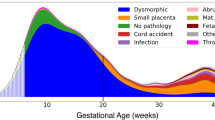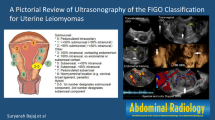Abstract
Purpose
The study’s aim is to define among a group of ultrasonographic cervical measurements a candidate parameter predictive of successful of induction of labor in term pregnancies with unfavorable cervix.
Methods
This prospective observational study included 141 pregnant women at term with an unfavorable cervix (Bishop score ≤ 6). All patients underwent clinical and ultrasonographic cervical evaluation before dinoprostone induction. Pre-induction cervical assessments included the Bishop score, cervical length, cervical volume, uterocervical angle, and cervical elastographic parameters. Vaginal delivery (VD) was accepted as successful dinoprostone induction. Multivariate logistic regression was conducted to identify the potential risk factors significantly associated with CS while controlling for possible confounding variables.
Results
The vaginal delivery rate was 74% (n = 93) and the cesarean section (CS) rate was 26% (n = 32). Sixteen patients who had a cesarean section due to fetal distress before the active phase of labor were excluded from the study. The mean induction-to-delivery interval was 1176.1 ± 352 (540–2150) for VD and 1359.4 ± 318.4 (780–2020) for CS (p = 0.01). Bishop score was lower in women with cesarean section (p = 0.002). When both groups were compared in terms of delivery type, no difference was found between cervical elastography values, cervical volume, cervical length, and uterocervical angle measurements. Multivariable logistic regression model failed to show significant differences between cervical elastography values, cervical volume, cervical length, and uterocervical angle measurements.
Conclusion
Cervical length, cervical elastography, cervical volume, and uterocervical angle measurements did not provide a clinically useful prediction of outcomes following labor induction in our study group with unfavorable cervix. Cervical length measurements significantly predicted the time interval from induction to delivery.



Similar content being viewed by others
Data availability
The data that support the findings of this study are not openly available due to reasons of sensitivity and are available from the corresponding author upon reasonable request.
References
Caughey AB, Sundaram V, Kaimal AJ, Cheng YW, Gienger A, Little SE, Padula A (2009). Maternal and neonatal outcomes of elective induction of labor
Verhoeven CJM, Opmeer BC, Oei SG, Latour V, Van Der Post JAM, Mol BWJ (2013) Transvaginal sonographic assessment of cervical length and wedging for predicting outcome of labor induction at term: a systematic review and meta-analysis. Ultrasound Obstet Gynecol 42:500–508
Kolkman DG, Verhoeven CJ, Brinkhorst SJ, van der Post JA, Pajkrt E, Opmeer BC, Mol BW (2013) The Bishop score as a predictor of labor induction success: a systematic review. Am J Perinatol 30(8):625–630. https://doi.org/10.1055/s-0032-1331024. (Epub 2013 Jan 2 PMID: 23283806)
Patabendige M, Athulathmudali SR (2021) Predicting the success of induction of labour using cervical volume. BMC Res Notes 14(1):453. https://doi.org/10.1186/s13104-021-05865-5.PMID:34922611;PMCID:PMC8684113
Athulathmudali SR, Patabendige M, Chandrasinghe SK, De Silva PHP (2021) Transvaginal two-dimensional ultrasound measurement of cervical volume to predict the outcome of the induction of labour: a prospective observational study. BMC Pregnancy Childbirth 21(1):433. https://doi.org/10.1186/s12884-021-03929-9.PMID:34158010;PMCID:PMC8218494
Singh PK, Srivastava R, Kumar I, Rai S, Pandey S, Shukla RC, Verma A (2022) Evaluation of uterocervical angle and cervical length as predictors of spontaneous preterm birth. Indian J Radiol Imaging 32(1):10–15. https://doi.org/10.1055/s-0041-1741411.PMID:35722650;PMCID:PMC9200462
Fruscalzo A, Schmitz R, Klockenbusch W, Steinhard J (2012) Reliability of cervix elastography in the late first and second trimester of pregnancy. Ultraschall Med 33:E101–E107
Pereira S, Frick AP, Poon LC, Zamprakou A, Nicolaides KH (2014) Successful induction of labor: prediction by preinduction cervical length, angle of progression and cervical elastography. Ultrasound Obstet Gynecol 44(4):468–475. https://doi.org/10.1002/uog.13411
Londero AP, Schmitz R, Bertozzi S, Driul L, Fruscalzo A (2016) Diagnostic accuracy of cervical elastography in predicting labor induction success: a systematic review and meta-analysis. J Perinat Med 44(2):167–178
Swiatkowska-Freund M, Preis K (2011) Elastography of the uterine cervix: implications for success of induction of labor. Ultrasound Obstet Gynecol 38:52–56
Hwang HS, Sohn IS, Kwon HS (2013) Imaging analysis of cervical elastography for prediction of successful induction of labor at term. J Ultrasound Med 32:937–946
Hee L, Rasmussen CK, Schlütter JM, Sandager P, Uldbjerg N (2014) Quantitative sonoelastography of the uterine cervix prior to induction of labor as a predictor of cervical dilation time. Acta Obstet Gynecol Scand 93:684–690
Fruscalzo A, Londero A, Frohlich C, Meyer-Wittkopf M, Schmitz R (2015) Quantitative elastography of the cervix for predicting labor induction success. Ultraschall Med 36:65–73
Nazzaro G, Saccone G, Miranda M, Crocetto F, Zullo F, Locci M (2022) Cervical elastography using E-cervix for prediction of preterm birth in singleton pregnancies with threatened preterm labor. J Matern Fetal Neonatal Med 35(2):330–335. https://doi.org/10.1080/14767058.2020.1716721
Dilek TUK, Gurbuz A, Yazici G, Arslan M, Gulhan S, Pata O et al (2006) Comparison of cervical volume and cervical length to predict preterm delivery by transvaginal ultrasound. Am J Perinatol 23(3):167–172. https://doi.org/10.1055/s-2006-934102
Rozenberg P, Rafii A, Senat MV, Dujardin A, Rapon J, Ville Y (2003) Predictive value of two-dimensional and three dimensional multiplanar ultrasound evaluation of cervix in preterm labor. J Matern Fetal Neonatal Med 13:237–241
Won YB, Han SW, Kim EH (2020) Clinical factors and ultrasound parameters to predict successful vaginal delivery following labour induction. J Obstet Gynaecol 40(3):360–366. https://doi.org/10.1080/01443615.2019.1647516
Kim JY, Kim HJ, Hahn MH, Jeon HJ, Cho GJ, Hong SC et al (2013) Three-dimensional volumetric gray-scale uterine cervix histogram prediction of days to delivery in full term pregnancy. Obstet Gynecol Sci 56(5):312–319. https://doi.org/10.5468/ogs.2013.56.5.312
Farràs Llobet A, Higueras T, Calero IZ, Marti LR, Maiz N, Goya MM et al (2020) Prospective evaluation of the uterocervical angle as a predictor of spontaneous preterm birth. Acta Obstet Gynecol Scand 99(11):1511–1518. https://doi.org/10.1111/aogs.13879
Uyar Y, Erbay G, Demir BC, Baytur Y (2009) Comparison of the Bishop score, body mass index and transvaginal cervical length in predicting the success of labor induction. Arch Gynecol Obstet 280:357–362
Grobman WA, Simon C (2007) Factors associated with the length of the latent phase during labor induction. Eur J Obstet Gynecol Reprod Biol 132:163–166
ACOG Practice Bulletin No (2009) 107: induction of labor. Obstet Gynecol 114:386–397
WHO Recommendations for Induction of Labour (2011) Geneva: world health organization; 1, BACKGROUND. Available from: https://www.ncbi.nlm.nih.gov/books/NBK131965/
Alfrevic Z, Keeney E, Dowswell T, Welton NJ, Medley N, Dias S et al (2016) Which method is best for the induction of labour? A systematic review, network meta-analysis and cost-efectiveness analysis. Health Technol Assess (Winch, Engl) 20:1–584
Pergialiotis V et al (2022) Efficacy and safety of oral and sublingual versus vaginal misoprostol for induction of labour: a systematic review and meta-analysis. Arch Gynecol Obstet. https://doi.org/10.1007/s00404-022-06867-9
Cavoretto PI et al (2021) Quantification of posterior risk related to intrapartum FIGO 2015 criteria for cardiotocography in the second stage of labor. Fetal Diagn Ther 48(2):149–157. https://doi.org/10.1159/000512658. (Epub 2021 Jan 28 PMID: 33508830)
Cavoretto PI et al (2023) Hazard and cumulative incidence of umbilical cord metabolic acidemia at birth in fetuses experiencing the second stage of labor and pathologic intrapartum fetal heart rate requiring expedited delivery. Arch Gynecol Obstet 307(4):1225–1232. https://doi.org/10.1007/s00404-022-06594-1. (Epub 2022 May 21. PMID: 35596749; PMCID: PMC10023766)
Seidenari A et al (2022) The cumulative incidence of neonatal metabolic acidemia after terminal bradycardia in the 2nd stage of labor: a survival-based model. Arch Gynecol Obstet. https://doi.org/10.1007/s00404-022-06619-9. (Epub ahead of print. PMID: 35635618)
Yuan L et al (2023) Efficacy and safety of double balloon catheter and dinoprostone for labor induction in multipara at term. Arch Gynecol Obstet. https://doi.org/10.1007/s00404-022-06891-9
Funding
The authors declare that no funds, grants, or other supports were received during the preparation of this manuscript.
Author information
Authors and Affiliations
Contributions
AI: protocol/project development, data collection or management, data analysis, and manuscript writing/editing. SYK: protocol/project development, data collection or management, and manuscript writing/editing. HG: data collection or management, and manuscript writing. MA: data collection or management, manuscript writing. AB: data collection or management, and manuscript writing. MÖ: data collection or management, and manuscript writing. HI: data analysis and manuscript writing/editing. MB: data collection or management. ARŞ: data collection or management. SAA: data collection or management. OÇT: data analysis. IK: data analysis, manuscript writing/editing, and review.
Corresponding author
Ethics declarations
Conflict of interest
The authors have no relevant financial or non-financial interests to disclose.
Ethical approval
This study was performed in line with the principles of the Declaration of Helsinki. Approval was granted by the Ethics Committee of Tepecik Training and Research Hospital (Date: 19/01/2021, No: 2021/01/02).
Additional information
Publisher's Note
Springer Nature remains neutral with regard to jurisdictional claims in published maps and institutional affiliations.
Rights and permissions
Springer Nature or its licensor (e.g. a society or other partner) holds exclusive rights to this article under a publishing agreement with the author(s) or other rightsholder(s); author self-archiving of the accepted manuscript version of this article is solely governed by the terms of such publishing agreement and applicable law.
About this article
Cite this article
İleri, A., Yıldırım Karaca, S., Gölbaşı, H. et al. Diagnostic accuracy of pre-induction cervical elastography, volume, length, and uterocervical angle for the prediction of successful induction of labor with dinoprostone. Arch Gynecol Obstet 308, 1301–1311 (2023). https://doi.org/10.1007/s00404-023-07076-8
Received:
Accepted:
Published:
Issue Date:
DOI: https://doi.org/10.1007/s00404-023-07076-8




